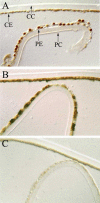Increased expression of osteonectin/SPARC mRNA and protein in age-related human cataracts and spatial expression in the normal human lens
- PMID: 10756178
- PMCID: PMC2831409
Increased expression of osteonectin/SPARC mRNA and protein in age-related human cataracts and spatial expression in the normal human lens
Abstract
Purpose: We have previously reported increased levels of Osteonectin/SPARC transcript in age-related cataractous compared to normal human lenses. The purpose of the present study was to evaluate the corresponding levels of osteonectin/SPARC protein in age-related cataractous relative to normal lenses and to evaluate the levels of osteonectin/SPARC transcript in specific types of age-related human cataracts. The spatial expression of osteonectin/SPARC was also evaluated in normal human lenses.
Methods: Specific types of age-related cataracts were collected and graded. Normal human lenses were microdissected into epithelia and fibers. Osteonectin/SPARC protein levels were monitored by Western immunoblotting, and transcript levels were evaluated by reverse transcriptase polymerase chain reaction (RT-PCR). Osteonectin/SPARC expression patterns were examined by RT-PCR and by immunostaining.
Results: Higher levels of osteonectin/SPARC protein were detected in age-related cataractous relative to normal human lenses. Increased levels of osteonectin/SPARC transcript were also detected in posterior-subcapsular and nuclear cataractous lenses relative to normal lenses. Osteonectin/SPARC transcripts were detected in the lens epithelium but not fibers. Osteonectin/SPARC protein levels were highest in the peripheral lens epithelium.
Conclusions: Consistent with our previous studies on osteonectin/SPARC mRNA levels, osteonectin/SPARC protein levels were also elevated in cataractous compared to normal human lenses. Increased levels of osteonectin/SPARC mRNA were also found in nuclear and posterior-subcapsular cataracts relative to normal lenses. Osteonectin/SPARC expression is confined to the lens epithelium, and osteonectin/SPARC levels are highest in the peripheral lens epithelium.
Figures




Similar articles
-
Up-regulation of osteonectin/SPARC in age-related cataractous human lens epithelia.Mol Vis. 1998 Sep 17;4:17. Mol Vis. 1998. PMID: 9743541
-
[Expression of osteonectin in lens epithelium cells in age-related cataract].Zhonghua Yan Ke Za Zhi. 2012 Jun;48(6):548-52. Zhonghua Yan Ke Za Zhi. 2012. PMID: 22943812 Chinese.
-
Absence of SPARC in murine lens epithelium leads to increased deposition of laminin-1 in lens capsule.Invest Ophthalmol Vis Sci. 2005 Dec;46(12):4652-60. doi: 10.1167/iovs.05-0460. Invest Ophthalmol Vis Sci. 2005. PMID: 16303962
-
[The oxidative stress in the cataract formation].Nippon Ganka Gakkai Zasshi. 1995 Dec;99(12):1303-41. Nippon Ganka Gakkai Zasshi. 1995. PMID: 8571853 Review. Japanese.
-
Messenger RNA population in normal and cataractous rat lens. A minireview.Lens Eye Toxic Res. 1989;6(4):749-72. Lens Eye Toxic Res. 1989. PMID: 2487280 Review.
Cited by
-
Secreted Protein Acidic and Rich in Cysteine in Ocular Tissue.J Ocul Pharmacol Ther. 2015 Sep;31(7):396-405. doi: 10.1089/jop.2015.0057. Epub 2015 Jul 13. J Ocul Pharmacol Ther. 2015. PMID: 26167673 Free PMC article. Review.
-
Secreted protein acidic and rich in cysteine (SPARC)-null mice exhibit more uniform outflow.Invest Ophthalmol Vis Sci. 2013 Mar 21;54(3):2035-47. doi: 10.1167/iovs.12-10950. Invest Ophthalmol Vis Sci. 2013. PMID: 23422826 Free PMC article.
-
Thrombospondin-1 (TSP1)-null and TSP2-null mice exhibit lower intraocular pressures.Invest Ophthalmol Vis Sci. 2012 Sep 28;53(10):6708-17. doi: 10.1167/iovs.11-9013. Invest Ophthalmol Vis Sci. 2012. PMID: 22930728 Free PMC article.
-
Matricellular proteins in the trabecular meshwork: review and update.J Ocul Pharmacol Ther. 2014 Aug;30(6):447-63. doi: 10.1089/jop.2014.0013. Epub 2014 Jun 5. J Ocul Pharmacol Ther. 2014. PMID: 24901502 Free PMC article. Review.
-
Evaluation of SPARC as a candidate gene of juvenile-onset primary open-angle glaucoma by mutation and copy number analyses.Mol Vis. 2010 Oct 8;16:2016-25. Mol Vis. 2010. PMID: 21042566 Free PMC article.
References
-
- Spector A. Aging of the lens and cataract formation. In: Sekuler R, Kline D, Dismukes K, editors. Aging and human visual function. A.R. Liss; New York: 1982. pp. 27–43.
-
- Brown NAP, Bron AJ. Lens disorders: a clinical manual of cataract diagnosis. Butterwoth-Heinemasnn; Oxford: 1996. pp. 53–133.
-
- Spector A. Oxidative stress-induced cataract: mechanism of action. FASEB J. 1995;9:1173–82. - PubMed
-
- Hightower KR. The role of the lens epithelium in development of UV cataract. Curr Eye Res. 1995;14:71–8. - PubMed
-
- Piatigorsky J. Lens differentiation in vertebrates. A review of cellular and molecular features. Differentiation. 1981;19:134–53. - PubMed
Publication types
MeSH terms
Substances
Grants and funding
LinkOut - more resources
Full Text Sources
Other Literature Sources
Medical
Miscellaneous

